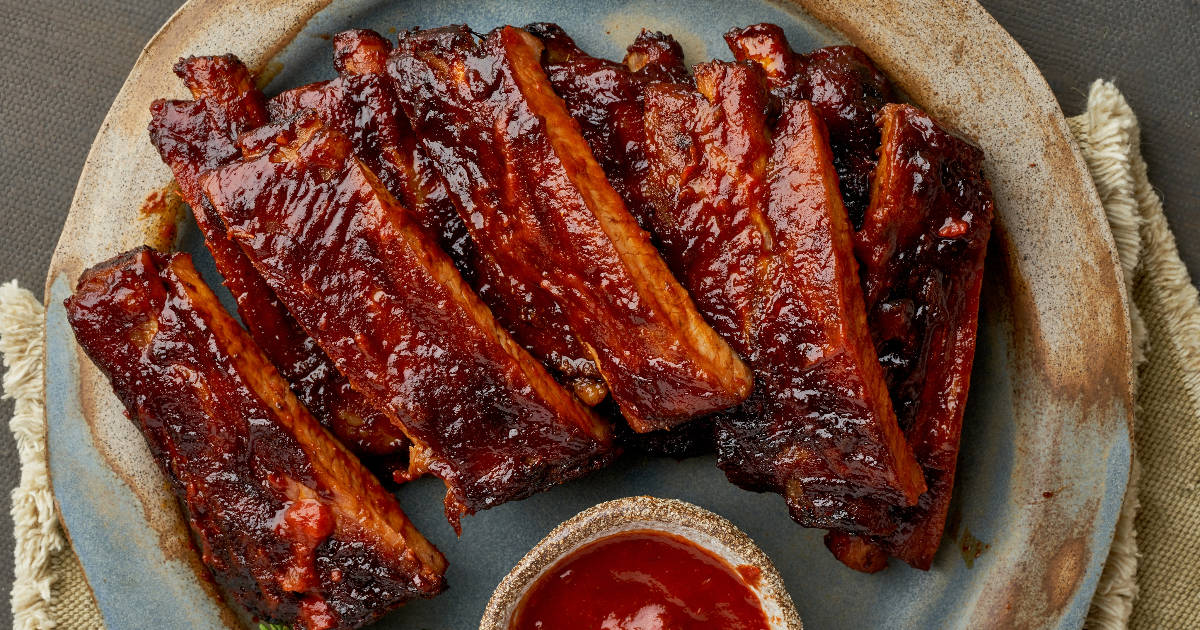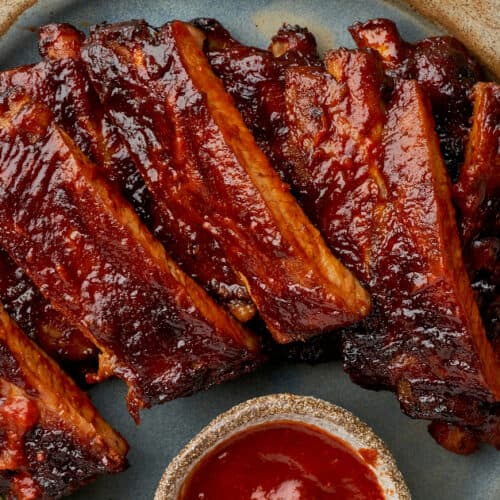Gochujang is a thick, rich Korean chili paste made from fermented soybeans, glutinous rice, red chili peppers, and salt. It provides a complex blend of sweet, spicy, and savory umami flavors.

Gochujang has recently exploded in popularity, becoming a staple ingredient in Korean and fusion barbecues. Its versatility allows it to be used as a rub, marinade, sauce, and condiment.
Let's explore why gochujang is ideal for making flavorful ribs on the grill or in the oven.
Selecting the Best Ribs for Gochujang BBQ
Baby back ribs are naturally tender with just the right amount of fat, making them ideal candidates for gochujang ribs. The thin cut allows the marinade to penetrate the meat. Look for racks with plenty of meat between the bones that are evenly trimmed.
Spare ribs have more connective tissue so require longer cooking, but their larger size means more surface area for that tasty glaze. Remove the skirt or membrane on the back before applying any rubs or marinade so flavors directly reach the meat.
For ultimate tenderness similar to baby backs, opt for St. Louis-style spare ribs. These are trimmed into uniform rectangles with the cartilage tip removed. This cut absorbs marinades easily.
While less common, beef short ribs also pair wonderfully with gochujang if you want to change up proteins. Choose ribs with thick, meaty sections for best results.
Crafting the Gochujang Marinade and Glaze
Making your own gochujang marinade allows you to control the flavor profile and spice level. Begin with 1/2 cup of gochujang and mix in sweeteners like brown sugar, honey, rice syrup, or fruit jam to balance the heat.
Add acidity from rice vinegar, lemon juice, or ginger. Soy sauce provides saltiness while sesame oil contributes a nutty aroma. Garlic, ginger, and onion bring aromatic pungency. Water or stock thins the paste into a sauce consistency.
Experiment with ingredients like miso, curry powder, five spices, citrus zest, fish sauce, chili oils, and oyster sauce to create your signature gochujang marinade.
Save some marinade to brush over the ribs as a glaze during the last few minutes of cooking. The sugars will caramelize into an irresistible sticky coating.
Marinating Methods for Maximum Flavor
Marinating the ribs overnight gives time for the gochujang to tenderize and penetrate the meat. At minimum marinate for 1-2 hours.
Place ribs in a sealed bag or baking dish with the marinade. Turn frequently to distribute evenly. Refrigerate to allow flavors to mingle.
For quicker marination, use a blender to puree the gochujang sauce then inject into ribs with a syringe. This forces flavor directly into the meat.
Before cooking, pat ribs dry so the sugars don't burn. Reserve used marinade for basting.
Low and Slow Oven Baking
While grilling imparts smoky depth, oven baking gives you more control over doneness. It also allows cooking ribs fully in advance for quicker weeknight meals or entertaining.
Preheat oven to 250-300°F. Place ribs meat-side up on a foil-lined baking sheet. Tightly wrap in more foil, sealing the edges to lock in the steam.
Bake for 2-3 hours until fork tender. Carefully drain juices from the foil into a bowl to use for glazing.
Unwrap the ribs and apply the reserved marinade. Broil for 5-10 minutes until bubbling and slightly charred. Rest for 10 minutes before cutting into individual ribs.
For ultra-tender results, finish ribs wrapped in foil on low heat in a slow cooker or Instant Pot. Top with glaze right before serving.
Smoking Ribs Over Indirect Heat
Opt for indirect heat to avoid burning the sugars in the gochujang glaze. Set up a two-zone fire in your grill with coals piled on only one side. Place a drip pan underneath the ribs on the empty side.
Add presoaked wood chips to generate aromatic smoke. Keep the temperature between 250-275°F and vents partially closed to maintain steady heat.
Cook ribs for 3-4 hours with the lid closed until meat pulls back from the bones. Flip and rotate for even cooking.
In the last 15 minutes, liberally brush ribs with glaze. Move over direct heat to caramelize the sauce. Let rest for 10 minutes before cutting.
For a sweet smoky flavor, try fruit wood chips like apple, cherry, peach, or pear paired with the fruity gochujang glaze.
Serving Suggestions for Gochujang Ribs
Gochujang ribs pair well with typical Korean barbecue sides like:
- Steamed rice
- Kimchi - Spicy fermented cabbage
- Bean sprout salad
- Roasted seaweed
- Quick pickled cucumbers
- Steamed egg custard
For fusion flavors, serve with:
- Coleslaw with sesame dressing
- Corn on the cob
- Macaroni salad
- Baked beans
- Cornbread
- Collard greens
Top ribs with crushed peanuts, sliced green onions, cilantro, and sesame seeds. Provide extra gochujang sauce for dipping.
Storage and Leftovers
Cooked gochujang ribs keep 3-4 days refrigerated. Store slices in an airtight container to prevent drying out.
Reheat gently in the microwave with a splash of water to restore moisture. Slices can also be crisped under the broiler.
For longer freezer storage up to 3 months, first wrap ribs in plastic then foil. Thaw in the refrigerator before reheating.
Make a double batch of ribs since the prep work is minimal. Freeze extra portions to enjoy later for quick meals. The sweet spicy glaze is always crave-worthy.
FAQ
What's the best way to get a thick glaze on the ribs?
After roasting or smoking the ribs until tender, generously brush them with the gochujang glaze and broil for 3-5 minutes until bubbling and slightly charred. The high heat caramelizes the sugars in the glaze to give a thick, sticky coating. You can also boil down excess marinade into a syrupy glaze.
Should I remove the membrane from the ribs?
Yes, peeling off the thin membrane or silver skin on the underside of the ribs helps seasonings and marinade better penetrate the meat. Use a knife to loosen an edge, grip it with a paper towel, and pull it off in one piece. This helps the ribs cook up more tender.
Can I use a slow cooker for gochujang ribs?
Absolutely! After marinating the ribs, cook on low heat in a slow cooker or Instant Pot for 4-6 hours until fall-off-the-bone tender. Add sauce during the last hour. Then broil with glaze to finish. The slow cooker allows you to start them in the morning for ready-to-eat ribs at dinner.
What drink pairs well with gochujang ribs?
The sweet heat of the ribs calls for a refreshing beverage pairing. Iced tea, lemonade, and fruit juices like apple or cranberry provide a nice contrast. Or try a Korean rice liquor like makgeolli, cider, wheat beer, ginger beer, or a citrusy pale ale. The tartness helps balance the spices.
Can I get restaurant-quality results at home?
Yes! Use meaty spare ribs or baby backs for the most tender results. Allow time to marinate so the gochujang can properly season the meat. Cook low and slow whether baking or grilling - don't rush the process. Finish with a sticky glaze and garnishes like sesame and scallions. Proper techniques will let you achieve professional quality right from your own kitchen.
Conclusion
With its complex blend of sweet, salty, spicy, and umami, gochujang boosts the flavor of ribs to new heights. Experiment with different cuts of pork or beef short ribs to find your perfect match for absorbing this Korean chili paste.
Tailor your own marinade and glaze to balance the savory fermented flavor with fresh aromatics. Whether oven-baked, smoked low and slow, or grilled over indirect heat, gochujang ribs deliver big, bold, sticky-sweet satisfaction.
Serve alongside classic Korean banchan or fusion sides for a tastebud adventure.
Give this rising star of barbecue a try to experience why smoky, spicy gochujang ribs are becoming a new favorite recipe.

Gochujang Ribs
Ingredients
- 2 racks baby back ribs (meaty, trimmed)
- 1/2 cup gochujang (Korean chili paste)
- 1/4 cup brown sugar (for sweetness)
- 2 Tbsp rice vinegar (for tang)
- 1 Tbsp sesame oil (for aroma)
- 3 garlic cloves, minced
- 1- inch ginger, grated
- Soy sauce, to taste
- Wood chips, soaked
Instructions
- Make marinade - Mix gochujang, brown sugar, rice vinegar, sesame oil, garlic, and ginger. Add soy sauce to taste.
- Coat ribs - Rub marinade all over ribs. Refrigerate 1-2 hours.
- Grill over indirect heat - Add soaked wood chips to coals for smoke flavor. Grill ribs over indirect heat at 250°F for 2-3 hours until tender.
- Glaze ribs - Brush ribs with marinade glaze and grill over direct heat to caramelize, about 5 minutes.
- Rest and serve - Let ribs rest 10 minutes before cutting into portions. Garnish with scallions and sesame seeds.

